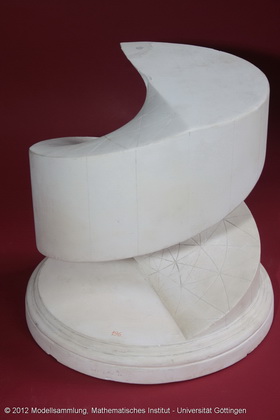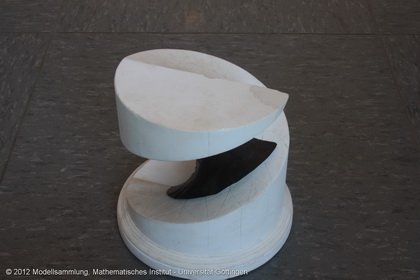Helical surface
Model 196
Description
Helical surface, and the brass plate 197.
Additions
The helicoid has been discovered to be the third known minimal surface by Jean Baptiste Meusnier in the year 1776. A minimal surface is a surface that locally minimizes its area
The helicoid emerges from regularly twisting a straight line along an axis perpendicular to said line.
A parameterization for the helicoid is \[x(u,v)=u\cdot \cos(v)\] \[y(u,v)= u\cdot \sin(v)\] \[z(u,v)=c\cdot v, \] where \(u,v \) are real parameters, and \(c \neq 0\) a real constant.
The helicoid is the only non-planar ruled surface, a surface that contains a straight line for every point on the surface.
The helicoid is part of a family of parameterized surfaces, it can be converted into the catenoid via continuous deformations. See model 195
In architecture, helicoids can be found as corkscrew stairs, as for example in the astrological tower in Copenhagen.
Showcase of this model is Case number 39
References
Schilling, Martin(Hrg.): Catalog mathematischer Modelle, Leipzig(Verlag von Martin Schilling) 1911, 7.Auflage, No.245. p. 147.
Fischer, Gerd(Hrg.): Fotoband: Mathematische Modelle / Mathematical Models, mit 132 Fotografien, Braunschweig/Wiesbaden (Vieweg) 1986, picture(s) 91. .
Fischer, Gerd(Hrg.): Mathematical Models, Commentary, Braunschweig/Wiesbaden(Vieweg) 1986. .
Separataband M4 im Mathematischen Institut p. 1.
Colding, M.(2011). A Course in Minimal Surfaces.
Eschenburg, J.(2007). Differentialgeometrie und Minimalflächen.



